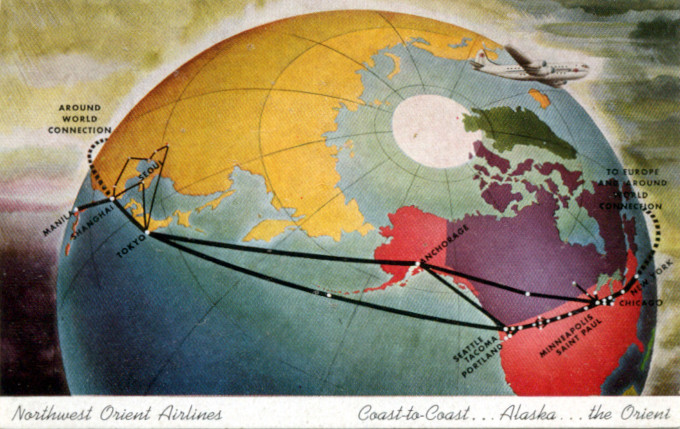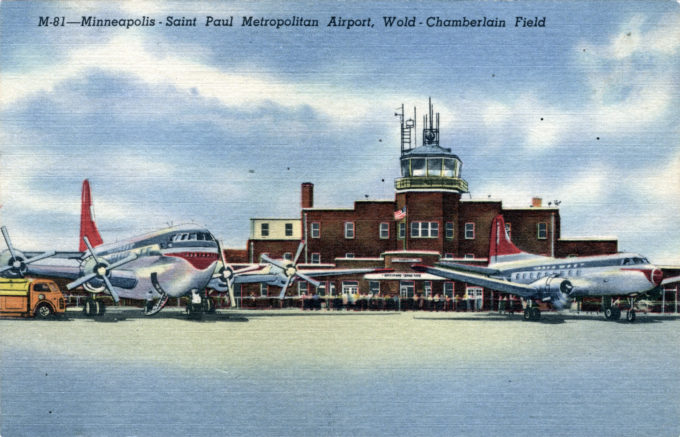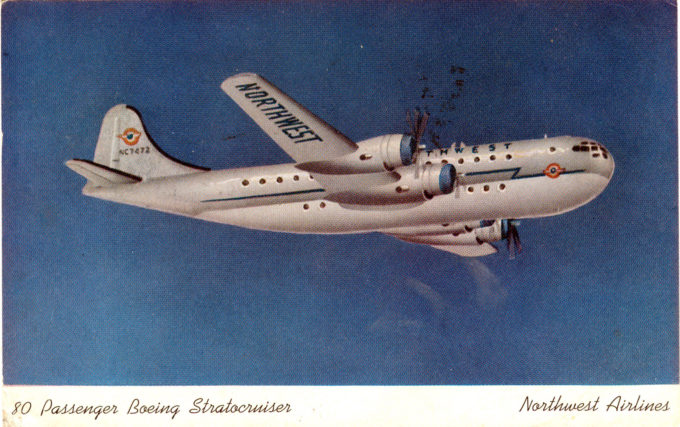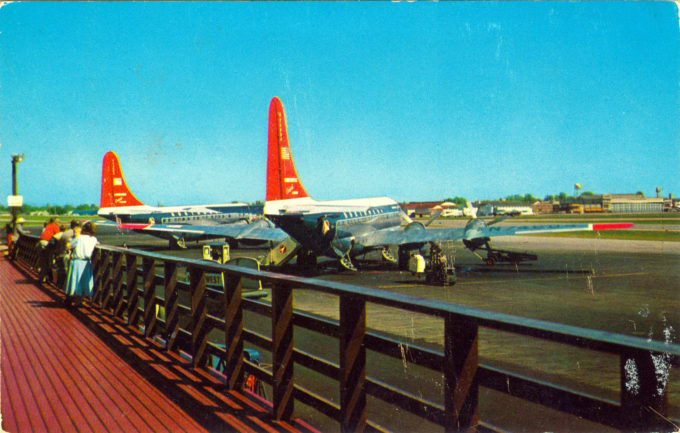
Promotional postcard depicting Northwest Orient Airlines’ North Pacific (“Great Circle”) routes map, c. 1949, prior to the removal of Shanghai, China, from its routes in May, 1949 at the aftermath of the Chinese civil war, and NWA’s acquisition of the “Stratocruiser” in the June, 1949. In 1931, Northwest sponsored Charles and Anne Morrow Lindbergh on a pioneering test flight to Japan via Alaska, scouting what would become known as the Northwest Airlines’ Great Circle route – one that could save as many as 2,000 miles (3,000 km) on a New York City to Tokyo flight.
“The Great Circle course (‘the shortest surface distance between two points on a sphere’) from New York to Tokyo points a straight line through Canada, and along the shores of the Arctic Sea, north to the Orient. This was the route we chose for our flight. The fact that it lay ‘on the edge of the frostie Zone’ did not imply the hardship and danger for us that it had for the Elizabethans.
“Far from being a deterrent factor in our trip, it was rather a provocative one. For by crossing this zone we intended to save mileage and time. The Arctic, my husband remarked as we studied the globe, heretofore had been explored chiefly for its own interest.
“An Arctic air route, although frequently discussed by explorers and aviators, had never been used primarily to shorten travel between the continents. It was Arctic air routes, and the conditions to be encountered following them, which we hoped to study on our voyage to the Orient.
“… Our route was new; the air untraveled; the conditions unknown; the stories mythical; the maps, pale, pink, and indefinite, except for a few names, far to the east of our course, to show that someone before us pointed his ship ‘North to the Orient.'”
– North to the Orient, by Anne Morrow Lindbergh, 1935

Minneapolis-St. Paul Wold-Chamberlain Field, c. 1949, depicting a NWA B-377 “Stratocruiser” (left) and DC-4 (right) in the “red tail” livery.
From the wiki: “In 1931, Northwest sponsored Charles and Anne Lindbergh on a pioneering test flight to Japan via Alaska, scouting what would become known as the Northwest Airlines’ Great Circle route – one that could save as many as 2,000 miles (3,000 km) on a New York City to Tokyo flight. Northwest developed this route further during World War II, when it flew soldiers and supplies from the Northwestern United States to Alaska. The airline’s experience with the sub-Arctic climate led the U.S. federal government to designate Northwest as the main airline over the North Pacific following the war.
“On July 15, 1947, Northwest became the first airline to begin direct service between the United States and Japan, using a Douglas DC-4 airliner named The Manila. (All pre-war airline service to the Orient had been via Hawaii and the Philippines.) The flight to Japan originated at Wold-Chamberlain Field in Minneapolis, with refueling stops at Blatchford Field in Edmonton, AB; Elmendorf AFB in Anchorage, AK; and Shemya AAF in the westmost Aleutian Islands. The flight continued from Tokyo to Lunghwa Airport in Shanghai, China (although Northwest service to Shanghai was suspended in May 1949 because of the civil war in China), and then on to Nichols Field at Manila, Philippines.
“With this new system of transpacific flights established, Northwest began to advertise itself as ‘Northwest Orient Airlines’. On June 22, 1949, Northwest received its first double-decker Boeing 377 ‘Stratocruiser’ airliner, enabling more comfortable accommodations and faster service on transpacific flights.
“For years, Northwest was the largest foreign airline serving Japan. In 1951 the US airline became involved with the founding of Japan Air Lines (JAL) by leasing airliners and crew members to the new airline. Northwest’s meteorologists, led by Dan Sowa, also pioneered the first clear-air turbulence forecasting system in 1957, important the advances in aircraft technology were allowing airlines to fly routes over turbulence-prone mountain areas. Northwest remained a leader in turbulence prediction, providing TPAWS (turbulence prediction and warning services) to other airlines.”
- Pre-acquisition promotional postcard for the Northwest Airlines B-377 “Stratocruiser” (NC-7472), c. 1948, before the airline’s adoption of the “Orient” and “red tail” livery in 1949.
- Northwest “Orient” Airlines “Stratocruisers” at Minneapolis-St. Paul Wold-Chamberlain Field, c. 1960, near the end of the airline’s use of the transoceanic propeller-driven airliner.



